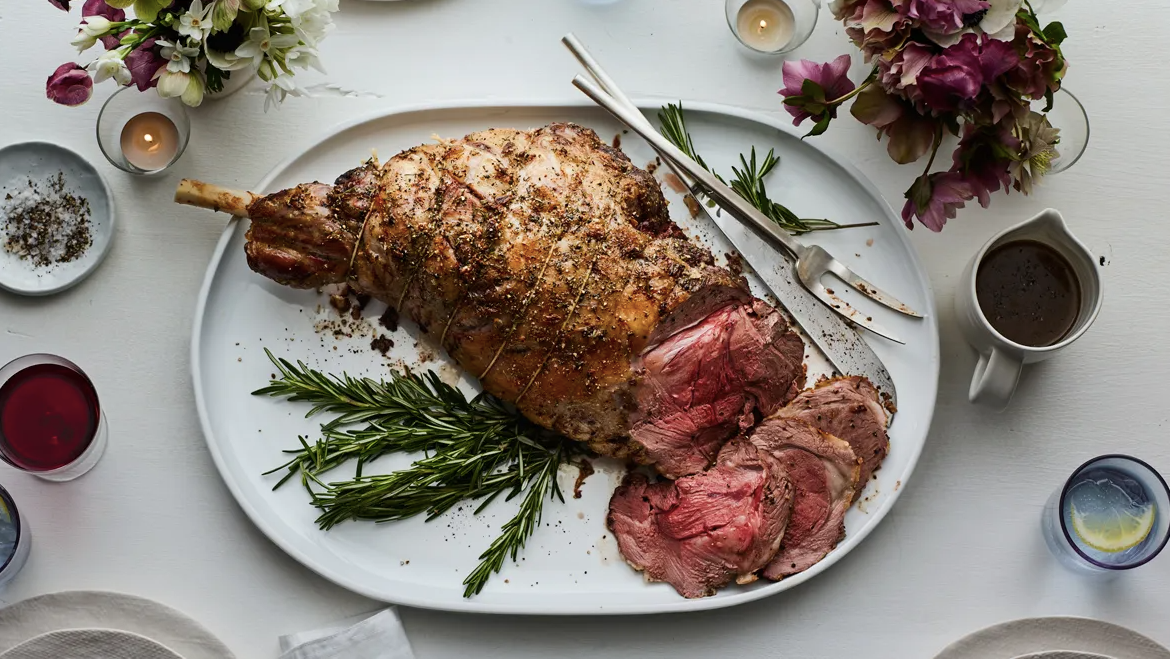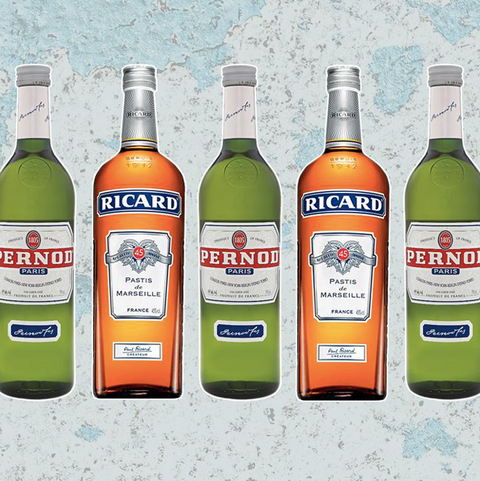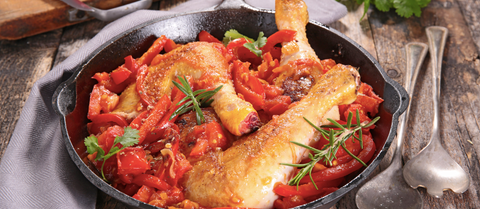What is Gigot Lamb?
Gigot is a French word for the leg of a lamb. The Gigot is more than just the leg. However, it's an entire cut of the lamb from hip to knee. This means that it includes the buttock and upper portion of the rear leg. It's a part that is rich in flavor because it comes from a muscle that gets lots of exercises.
Gigot, also known as the leg of lamb or lamb shank, is a cut of lamb from the upper part of the leg. It may be prepared whole, boned or semi-boned.
Gigot is the French word for leg, and Gigot à la bretonne (Breton-style leg) is a classic French dish. In addition, Gigot can refer to lamb cooked with peas, onions, and oregano in Italian cuisine. Gigot chops are the equivalent of mutton chops.
Gigot may be cooked in many ways:
- roasted
- fried
- braised
- or grilled
Best way to cook a Gigot Chop
The best way to cook a gigot chop is to preheat your oven to 400°F, roast the chops for 20 minutes, reduce the temperature to 375°F, and cook them for another 20-30 minutes.
And as you can see from this recipe, you don't need much else other than some salt and pepper:
- 1. Remove the chops from the refrigerator about an hour before cooking.
- Set the oven rack in the middle position. Preheat the oven to 400°F.
- Place a large cast-iron skillet on high heat until it is hot enough that a drop of water sizzles when it hits the pan.
- Salt and pepper on both sides of each chop.
- Place the chops in the pan and sear until dark brown on one side — about 3 minutes — then flip them over and sear on the other side for another 2 minutes.
- Place the entire pan in the oven (careful not to burn yourself) and roast for 20 minutes. Reduce oven temperature to 375°F and flip each chop over so that they are seared side up. Cook until internal temperature reaches 130°F, another 20-30 minutes depending on how thick your chops are.
Does Lamb get tenderer the longer you cook it?
The key to cooking any tough cut is slow simmering over low heat—lamb shoulder could take two hours to reach the tender zone. The muscle fibers in the shoulder are rich in collagen, which can be broken down into gelatin for more prosperous, more flavorful meat (but that takes time). High oven temperatures can give meat dishes a seared, browned exterior, but it will not make a significant difference in the overall tenderness of the meat.
The shoulder is best suited to being roasted or braised. The longer you cook it, the tenderer it will get. But there's a limit! If you cook it long enough, the protein breaks down so much that it becomes mushy. The other problem is that overcooking will cause the meat to dry out and lose its moisture.
When you have time for a leisurely roast on a weekend afternoon, we suggest 2¼ to 2½ hours at 350˚F for medium-rare lamb shoulder (145˚F internal temperature). Less time will give you medium-rare lamb with some chewier bits; more prolonged cooking will produce tenderer meat but may dry it out.
You can use a probe thermometer to monitor the lamb's temperature while roasting checking.
Lamb is a tender meat
Lamb is very tender meat, especially beef, so there is no need to cook it for hours. I have even seen recipes that call for cooking it for a minute per side!
The quality of the meat is crucial, though - it needs to be good quality and fresh. So I would say that the best way of cooking lamb is medium-rare so that it is still tender and juicy.
If you are worried about bacteria (pregnant women or anyone with low immunity), then you should cook it through. However, you can still make it pleasant by marinating it first in some yogurt and herbs, like coriander and mint, which will tenderize and flavor the meat.
Browning Lamb leg before roasting
Lamb's leg is a significant cut that benefits from the flavor and texture browning can add. This means it's a great candidate for braising, stewing, and even grilling. However, for the most tender and flavorful result, it's best to skip Browning when roasting lamb leg.
A good rule of thumb when roasting meat is to brown it first if you're going to be braising or stewing it in liquid, but not if you're roasting it dry. The reasoning behind this has to do with the way moisture and heat interact with protein as they cook.
- Browning meat caramelizes the proteins on its surface, adding flavor through the Maillard reaction — a complex chemical interaction between proteins and sugars under high heat. It also adds texture by creating a crisp crust around the meat that helps to seal in juices during cooking. This is especially important for lean cuts like lamb leg because there isn't much fat to keep them moist as they cook through.
This method works well for braising or stewing because long cooking times in liquid break down tough connective tissue and tenderize the meat naturally while allowing the flavor of any aromatics you add to penetrate deep into the meat. Browning first enhances these effects by adding complexity.
How to keep the lamb moist when roasting?
This depends on the size of the leg and how you want to cook it, but I would consider a leg of lamb to be anything between 4 1/2 to 7 1/2 pounds. When roasting, I would cook it in a moderate oven (350-375F) until it reaches an internal temperature of 140-145F. This should take anywhere from 1 hr. 15 min to 2 hrs. 15 min depending on the size of your roast.
An instant-read thermometer is the best way to determine if the roast is done. If you don't have one, take the roast out of the oven when you think it's done and let it rest for about 20 minutes. The temperature will continue to rise about 10 degrees, depending on its size and temperature.
Another trick is not to wrap the roast in foil while cooking, as this will steam the meat instead of roasting it.

You can do a few things to keep the lamb moist when roasting
- Use a wet cooking method. Roasting isn't the only way to cook lamb. Braising it in a flavorful liquid such as broth, wine, or stock will keep the meat moist and tender. Lamb shanks are often cooked this way, but you can also braise racks of lamb.
- Add garlic and salt. Seasoning the lamb before cooking will keep it moist and add flavor to the meat. You can rub it with a combination of salt, pepper, and garlic or use a marinade if you want more flavors.
- Let it rest. When you're done roasting the lamb, let it rest for 15 to 20 minutes before carving so that the juices redistribute throughout the meat instead of running out onto your cutting board.
Cooking Lamb in a foil
Cooking lamb in foil is not common, but it's certainly possible. The easiest way to do this is to cook the meat sous vide, although you can also use conventional methods if you're careful.
Sous vide works by cooking meats in a water bath at a low temperature. The advantage of this method is that you can't overcook the meat because the water temperature never rises above your desired final internal temperature of the meat.
- So, for example, you can leave lamb chops in sous vide bath for several hours, and they'll still come out perfectly cooked.
- However, it would help if you seared them off before serving to give them a crust and add flavor. This can be done on a grill or with a blow torch, but it's far easier just to put them under the broiler for 30 seconds or so.
Cooking lamb without any liquid is also possible, but it's difficult because the fat needs to be rendered from the meat before it browns. If you do this, it should be under constant supervision and frequently turned to avoid burning.
Lamb is red meat with a rich, full flavor. It is often sold in large pieces that can be roasted or cut into smaller roasts, chops, and steaks. Lamb is delicious when prepared in the oven or on the grill, but it can be tricky to cook because of its high-fat content.
Cooking lamb in foil helps keep;
- The meat tender and juicy while minimizing cleanup.
- The juices from the lamb mix with any seasonings you add to create a sauce inside the foil while it cooks.
- It's best to season the lamb before adding it to the foil as this prevents any of the flavorings from washing off during cooking.
Best temperature to roast Lamb
Lamb has a reputation for being tricky to cook. A perfectly roasted leg of lamb is meltingly tender and juicy, but if you overcook it, you end up with dry meat that's tough to chew.
The best temperature for roasting lamb is 350°F (175°C). This will give your meat a nice golden-brown color on the exterior and make it medium rare in the center.
It's a good idea to take your lamb out of the fridge about an hour before cooking. This allows it to come to room temperature and make the cooking process more even.
Which is the better bone in or boneless leg of Lamb?
Lamb is a tender and flavorful meat that can be prepared in many ways. However, it is relatively expensive, so you should care when preparing it to make sure it comes out perfectly. Leg of lamb is one of the most popular cuts, but choosing between bone-in and boneless leg of lamb can be tricky.
- There is no definitive answer as to which cut is better. Both types have pros and cons, so the choice depends on your preferences and cooking method. In general, a leg of lamb with the bone in will have more flavor than a boneless leg of lamb, but it will also be harder to carve.
Bone-in leg of lamb is usually roasted whole, while the boneless leg of lamb can be cut up into smaller pieces or rolled up before cooking. This makes the latter easier to prepare, making it less attractive visually.
Different cuts of the lamb
There are many different cuts of lamb, and each cut has its uses. The cut you choose will depend on how you want to cook it, how tender the meat needs to be, how many people you're feeding, and how much money you want to pay per pound.
The leg is the hind leg of a sheep or lamb. It's one of the most versatile cuts of the lamb because it's tender enough for roasting and tough enough for braising and stewing. In terms of flavor, it's one of the best-tasting parts of the animal.
The leg has two main sections:
The top half is round, and a large muscle is used while the animal is alive, making it less tender than other parts.
The bottom half is the sirloin, a very tender and round bone.
When deciding whether to buy bone-in or boneless leg of lamb, keep in mind that there are pros and cons to both:
Should you seal a leg of lamb before roasting?
We've had this discussion before, but given the amount of leg of lamb we'll be seeing at Easter and Passover meals in the coming weeks, it seemed a good time to revive it.
When you roast a leg of lamb, should you sear it first? As in so many cases, the answer is "it depends."
We called for searing the meat first in our recent roast leg of lamb recipe. Seared on all sides, then roasted to medium-rare or medium doneness, the exterior of this lamb is well browned and flavorful. The meat is tender and juicy.
Some readers complained that this method took too long; they didn't want to wait for the meat to cool before carving. But, truthfully, it takes about 10 minutes for a leg of lamb to cool enough so that you can easily slice it into neat medallions (and even less if you cut the slices thick enough). So that shouldn't be an issue.




